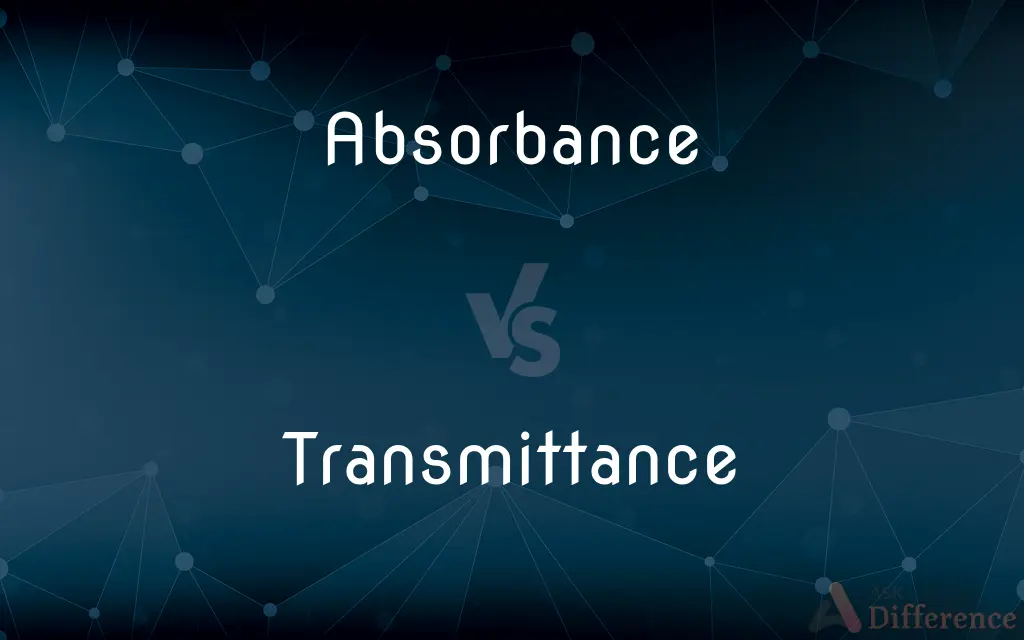Absorbance vs. Transmittance — What's the Difference?
By Tayyaba Rehman — Updated on September 23, 2023
Absorbance measures how much light a material absorbs, while transmittance measures how much light passes through. Both are related and offer insights into a substance's optical properties.

Difference Between Absorbance and Transmittance
Table of Contents
ADVERTISEMENT
Key Differences
Absorbance, in the field of spectrophotometry, quantifies the amount of light that a sample absorbs. It is a dimensionless quantity that is log inversely proportional to the fraction of light that passes through the sample. In simpler terms, a high absorbance value means the sample is absorbing a significant amount of the incident light.
Transmittance, on the other hand, gauges the fraction of incident light that makes its way through a material or sample. It's usually presented as a percentage, and a high transmittance value suggests that the material is largely transparent to the particular wavelength of light being examined.
It's crucial to note that absorbance and transmittance are inversely related. As the absorbance of a sample rises, its transmittance falls and vice versa. This inverse relationship ensures that, for a given wavelength of light, the sum of absorbance and the logarithm of transmittance is a constant.
These two metrics are central in fields like chemistry, physics, and biology, especially when investigating the properties of solutions or materials. By understanding absorbance and transmittance, scientists can deduce concentrations, purity, and other characteristics of samples they're examining.
Comparison Chart
Definition
Measures how much light is absorbed by a material.
Measures how much light passes through a material.
ADVERTISEMENT
Presentation
Dimensionless number.
Usually as a percentage.
Relationship
Inverse to transmittance.
Inverse to absorbance.
Equation
A = -log(T) or A = log(1/T)
T = 10^(-A)
Implication
High absorbance indicates low light passage.
High transmittance indicates high light passage.
Compare with Definitions
Absorbance
The measure of light absorbed by a substance.
The absorbance of the solution increased with concentration.
Transmittance
Expressed as a percentage of the incident light.
The glass had a transmittance of 95% for sunlight.
Absorbance
The logarithmic ratio of incident to transmitted light.
With more dye, the absorbance of the liquid went up.
Transmittance
Reflects how substances interact with light.
Different crystals have varied light transmittance properties.
Absorbance
Indicates how opaque a sample is.
Opaque materials generally have high absorbance.
Transmittance
Helps determine material transparency.
Materials with high transmittance are generally transparent.
Absorbance
Used to determine the concentration in Beer's Law.
The absorbance of the sample helped determine its concentration.
Transmittance
The fraction of light that passes through a substance.
Clear water has high transmittance for visible light.
Absorbance
Related to the intrinsic properties of materials.
Different chemicals show distinct absorbance spectra.
Transmittance
Opposite of absorbance in a material's behavior.
As the solution darkened, its transmittance decreased.
Absorbance
Absorbance is commonly defined as "the logarithm of the ratio of incident to transmitted radiant power through a sample (excluding the effects on cell walls)". Alternatively, for samples which scatter light, absorbance may be defined as "the negative logarithm of one minus absorptance, as measured on a uniform sample".
Transmittance
Transmittance of the surface of a material is its effectiveness in transmitting radiant energy. It is the fraction of incident electromagnetic power that is transmitted through a sample, in contrast to the transmission coefficient, which is the ratio of the transmitted to incident electric field.Internal transmittance refers to energy loss by absorption, whereas (total) transmittance is that due to absorption, scattering, reflection, etc.
Absorbance
(physics) A logarithmic measure of the amount of light that is absorbed when passing through a substance; the capacity of a substance to absorb light of a given wavelength; optical density.
Transmittance
A transmission.
Transmittance
(Physics) The ratio of the radiant energy transmitted to the total radiant energy incident on a given body.
Transmittance
A transmission
Transmittance
(physics) the fraction of incident light, or other radiation, that passes through a substance
Transmittance
Transmission.
Transmittance
The fraction of radiant energy that passes through a substance
Common Curiosities
Do higher absorbance values mean more light is absorbed?
Yes, a higher absorbance indicates more light absorption by the material.
Why are absorbance and transmittance important in chemistry?
They help determine concentrations, purity, and properties of substances.
How are absorbance and transmittance related mathematically?
Absorbance (A) and transmittance (T) relate as: A = -log(T).
Can a material have high absorbance and high transmittance at the same time?
No. They are inversely related; as one increases, the other decreases.
Is transmittance always presented as a percentage?
Typically, yes. It represents the percentage of incident light transmitted.
Share Your Discovery

Previous Comparison
Multimorbid vs. Comorbid
Next Comparison
Profit vs. GainAuthor Spotlight
Written by
Tayyaba RehmanTayyaba Rehman is a distinguished writer, currently serving as a primary contributor to askdifference.com. As a researcher in semantics and etymology, Tayyaba's passion for the complexity of languages and their distinctions has found a perfect home on the platform. Tayyaba delves into the intricacies of language, distinguishing between commonly confused words and phrases, thereby providing clarity for readers worldwide.














































